Introduction
Bonsai trees are small trees grown in containers that mimic their full-size counterparts in nature. They are cultivated to look like mature trees in miniature form and require specialized care. Here, we will explore the basics of taking care of a bonsai tree so you can enjoy it for years to come.
Choosing the Right Pot and Soil for Your Bonsai Tree
The first step to caring for a bonsai tree is finding the right pot and soil mix. The size and shape of the pot should accommodate the root system of the tree, while allowing enough space for future growth. Pots with drainage holes are ideal to prevent root rot and other problems caused by excess water.
When choosing a soil mix, make sure to pick one specifically designed for bonsai trees. It should be well-draining and contain organic matter, such as bark, compost, or peat moss. This will provide essential nutrients to the tree and help retain moisture without becoming soggy. If possible, combine two or more types of soil mixtures to create the ideal environment for your bonsai tree.
Understanding Proper Watering Techniques
Watering is one of the most important aspects of bonsai tree care. It’s important to understand how often to water and when to stop in order to prevent overwatering or underwatering. Generally, a bonsai tree should be watered every day or every other day. You can determine if your tree needs water by checking the soil–if it’s dry to the touch, it’s time to water.
Overwatering can lead to root rot and other problems, while underwatering can cause the leaves to turn yellow and drop off. To avoid both of these issues, water your tree until the water runs out of the drainage holes at the bottom of the pot. If you notice any signs of root rot, stop watering and repot the tree in fresh soil.

Fertilizing Your Bonsai Tree Regularly
In addition to regular watering, bonsai trees need to be fertilized regularly. The type of fertilizer you use should be specific to bonsai trees and contain a balanced mixture of nitrogen, phosphorus, and potassium. It’s best to fertilize your tree once a month during the growing season (spring and summer) and once every two months during the dormant season (fall and winter).
When applying fertilizer, be careful not to overdo it. Too much fertilizer can burn the roots and cause leaf discoloration. Start by mixing the fertilizer with water according to package instructions and apply it to the soil around the base of the tree. Make sure to water the soil after fertilizing to help the nutrients reach the roots.

Pruning and Shaping Your Bonsai Tree
Pruning and shaping are essential components of bonsai tree care. Pruning involves removing dead or diseased branches and stems, as well as cutting back foliage to encourage new growth. There are several different pruning techniques, including pinching, trimming, and wiring. Each technique has its own purpose and should only be used on certain types of bonsai trees.
When pruning and shaping, it’s important to use the right tools. Bonsai shears, scissors, and tweezers are all necessary for safely and effectively trimming and wiring branches. Be sure to sterilize your tools before and after each use to prevent the spread of disease.

Providing Adequate Sunlight and Temperature Conditions
Bonsai trees need plenty of sunlight to thrive. Natural sunlight is best, but if that’s not available, you can use artificial light sources such as fluorescent bulbs or LED lights. In terms of temperature, bonsai trees prefer temperatures between 65 and 75 degrees Fahrenheit. Avoid extreme temperature fluctuations, as these can shock the tree and cause damage.
Conclusion
Caring for a bonsai tree is an enjoyable and rewarding experience. By following the tips outlined above, you can ensure your bonsai tree receives the proper care it needs to stay healthy and beautiful. Choose the right pot and soil mix, understand proper watering techniques, fertilize regularly, prune and shape the tree, and provide adequate sunlight and temperature conditions for the best results.


